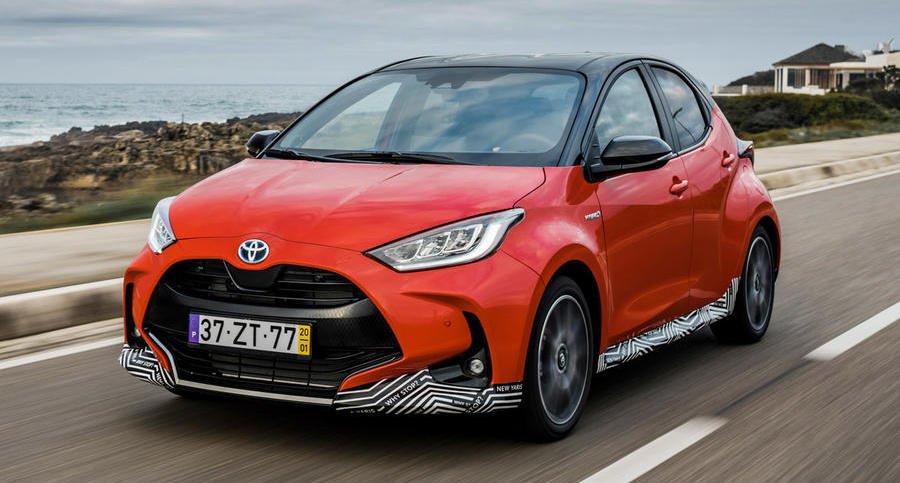Behind the least convincing camouflage we've ever seen is the fourth-generation Toyota Yaris. No, it isn't the GR-Four (it has too many doors for that), but the far more real-world relevant hybrid model that will make up the vast majority of sales.
Of course, with everyone jumping on the electrified bandwagon of late, Toyota must be feeling jolly smug with itself. After all, it has been making hybrid versions of the Yaris since 2012.
But this isn't some heavily facelifted version of the third-gen car; it's an all-new model from the ground up. For a start, its platform has been switched to a version of the TNGA architecture that underpins the Corolla, bringing a 37% increase in torsional rigidity. Width is up by 50mm, as is the wheelbase, but overall length is down by 5mm. Height has been reduced as well, bringing about a 21mm lower seating position and a 12mm drop in the centre of gravity.
Those changes are all attempts to boost agility and driver appeal, but would have been pointless with the sluggish old hybrid system. Thankfully, there's a new 1.5-litre three-cylinder Atkinson cycle engine under the bonnet. This long-stroke engine is paired with two electric motors and a lighter, more powerful Li-ion battery pack to give 16% more power, yet brings a 20% reduction in CO2 emissions.
With a combined output of 114bhp, 0-62mph is reduced by two seconds to a perfectly respectable 10.3sec, and the power boost also means the new car's engine doesn't have to be worked as hard, making it far quieter while delivering useful acceleration. Most of the time, you'll find the Yaris a quiet partner; its distant engine thrum is more subdued than you'll hear in many rivals. You still occasionally find the revs soaring and staying there – a trait that comes courtesy of the hybrid's CVT automatic gearbox – but the motor doesn't sound quite so tortured when this happens.
Not that the engine is running much of the time, at least in urban environments. Indeed, Toyota claims that the Yaris can run on electricity 80% of the time, something we can entirely believe. The handover between power sources is virtually imperceptible; there's only a bit of engine noise and a faint vibration through the steering wheel to tell you that the Yaris is sipping petrol. And 'sipping' is the right word; on our two-hour test route, which included towns, motorways and even some challenging mountain passes, we averaged 61.4mpg, according to the trip computer.
That economy is particularly impressive when you consider that the Yaris is now far happier to be driven briskly on a winding road. Its steering might not be particularly talkative, but it's naturally weighted and very precise, making it easy to place on the road, while body lean is far less noticeable. Grip is decent and the handling is surefooted yet agile. Sure, you'd have more fun in a Ford Fiesta thanks to its feelsome steering, delightful manual 'box and more neutral balance, but at least corners are now something to be enjoyed and not avoided. The downside is that, on the 17in wheels of our test car – the largest available on the Yaris – the ride is on the firm side. It's perfectly pleasant on smooth but undulating roads, but larger potholes and pimples can thud through the car uncomfortably.
Hopefully things will improve on smaller wheels, but it's also worth remembering that this car isn't the finished product. We should, then, make an allowance for the interior, where we encountered a few plastics that weren't quite up to production grade. Even so, the squishy dashboard, large fabric inserts on the doors and expensive-feeling switches and buttons impressed us. Sadly, the dim-witted infotainment system with its yesteryear graphics and sluggish responses put a downer on things, especially because the hard-to-follow sat-nav got us lost several times.
As for space, the 286-litre boot is on the small side, although most versions will get a two-level boot floor for added flexibility. Space inside is better, with room for a 6ft-plus adult to sit behind another in the driving seat.
There's no doubt that the Yaris has taken a big step forwards, improving on its already excellent economy and emissions whilst being noticeably better to drive. It might not have the Fiesta's sparkle in the bends, but it certainly handles far more tidily, while its powertrain is much less frustrating.
Just how competitive it is will boil down to pricing and specifications, plus how vigorously Toyota will be applying the final layer of polish. But although it's too early to give a definitive verdict, expect the Yaris to climb the supermini rankings.
Where Cascais, Portugal Price £16,000 (estimated) On sale September Engine 3-cyls, 1.5-litre plus two electric motors and Li-ion battery Power 114bhp (combined) Torque TBC Gearbox CVT automatic Kerb weight TBC 0-62mph 10.3sec Top speed TBC Fuel economy TBC CO2 86g/km (WLTP) Rivals Seat Ibiza, Volkswagen Polo
Nouvelles connexes



